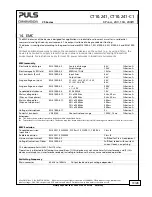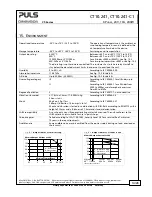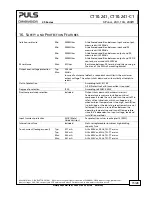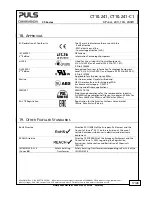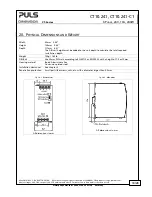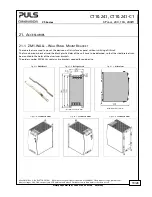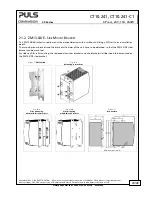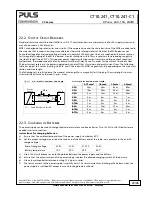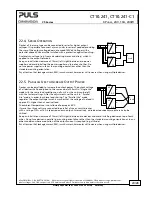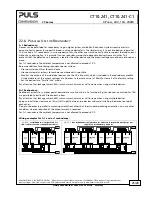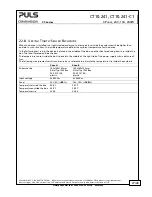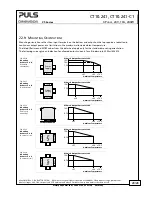
CT10.241, CT10.241-C1
CT-Series
3-P
HASE
,
24V,
10A,
240W
May 2018 / Rev. 2.0a DS-CT10.241-EN All values are typical figures specified at 3x 400Vac, 50Hz input voltage, symmetrical
phase voltages, 24V, 10A output load, 25°C ambient and after a 5 minutes run-in time unless otherwise noted.
www.pulspower.com Phone +49 89 9278 0 Germany
25/28
22.6.
P
ARALLEL
U
SE FOR
R
EDUNDANCY
1+1 Redundancy:
Devices can be paralleled for redundancy to gain higher system availability. Redundant systems require a certain
amount of extra power to support the load in case one device fails. The simplest way is to put two devices in parallel.
This is called a 1+1 redundancy. In case one device fails, the other one is automatically able to support the load current
without any interruption. It is essential to use a redundancy module to decouple devices from each other. This
prevents that the defective unit becomes a load for the other device and the output voltage cannot be maintained any
more.
For 1+1 redundancy the ambient temperature is not allowed to 70°C.
Recommendations for building redundant power systems:
- Use separate input fuses for each device.
- Use separate mains systems for each device whenever it is possible.
- Monitor the outputs of the individual devices. Use the DC-ok contact, which is included in the redundancy module.
- It is desirable to set the output voltages of all devices to the same value (± 100mV) or leave it at the factory setting.
- Set the devices into “Parallel Use” mode.
Pay attention that leakage current, EMI, inrush current, harmonics will increase when using multiple devices.
N+1 Redundancy:
Redundant systems for a higher power demand are usually built in a N+1 method. E.g. four devices, each rated for 10A
are paralleled to build a 30A redundant system.
Pay attention that leakage current, EMI, inrush current, harmonics will increase when using multiple devices.
Keep an installation clearance of 15mm (left / right) between two devices and avoid installing the devices on top of
each other.
Do not use devices in parallel in mounting orientations other than the standard mounting orientation or in any other
condition, where a reduction of the output current is required.
For 1+1 redundancy the ambient temperature is not allowed to 60°C.
Wiring examples for 1+1 and n+1 redundancy:
Fig. 22-4
1+1 Redundant configuration for
10A load current and redundancy modules
Fig. 22-5
N+1 Redundant configuration for 30A load current with multiple power
supplies and redundancy modules
Failure
Monitor
Power
Supply
+ +
- -
L1 L2
PE
Output
Input
L3
I
I
L1
L2
I
I
PE
opt
ional
Power
Supply
+ +
- -
L1 L2
PE
Output
Input
L3
I
L3
I
YRM2.DIODE
Redundancy
Module
Output
Input
1
Input
2
+
-
+
-
+
-
o o o o
2
1
Input ok
YRM2.DIODE
Redundancy
Module
Output
Input
1
Input
2
+
-
+
-
+
-
o o o o
2
1
Input ok
Load
Failure
Monitor
Power
Supply
+ +
- -
L1 L2
PE
Output
Input
L3
I
L1
L2
I
I
PE
opt
ional
Power
Supply
+ +
- -
L1 L2
PE
Output
Input
L3
I
L3
I
YRM2.DIODE
Redundancy
Module
Output
Input
1
Input
2
+
-
+
-
+
-
o o o o
2
1
Input ok
YRM2.DIODE
Redundancy
Module
Output
Input
1
Input
2
+
-
+
-
+
-
o o o o
2
1
Input ok
Load
I I
opt
ional
Power
Supply
+ +
- -
L1 L2
PE
Output
Input
L3
I
YRM2.DIODE
Redundancy
Module
Output
Input
1
Input
2
+
-
+
-
+
-
o o o o
2
1
Input ok
I I
opt
ional
Power
Supply
+ +
- -
L1 L2
PE
Output
Input
L3
I
YRM2.DIODE
Redundancy
Module
Output
Input
1
Input
2
+
-
+
-
+
-
o o o o
2
1
Input ok
I



